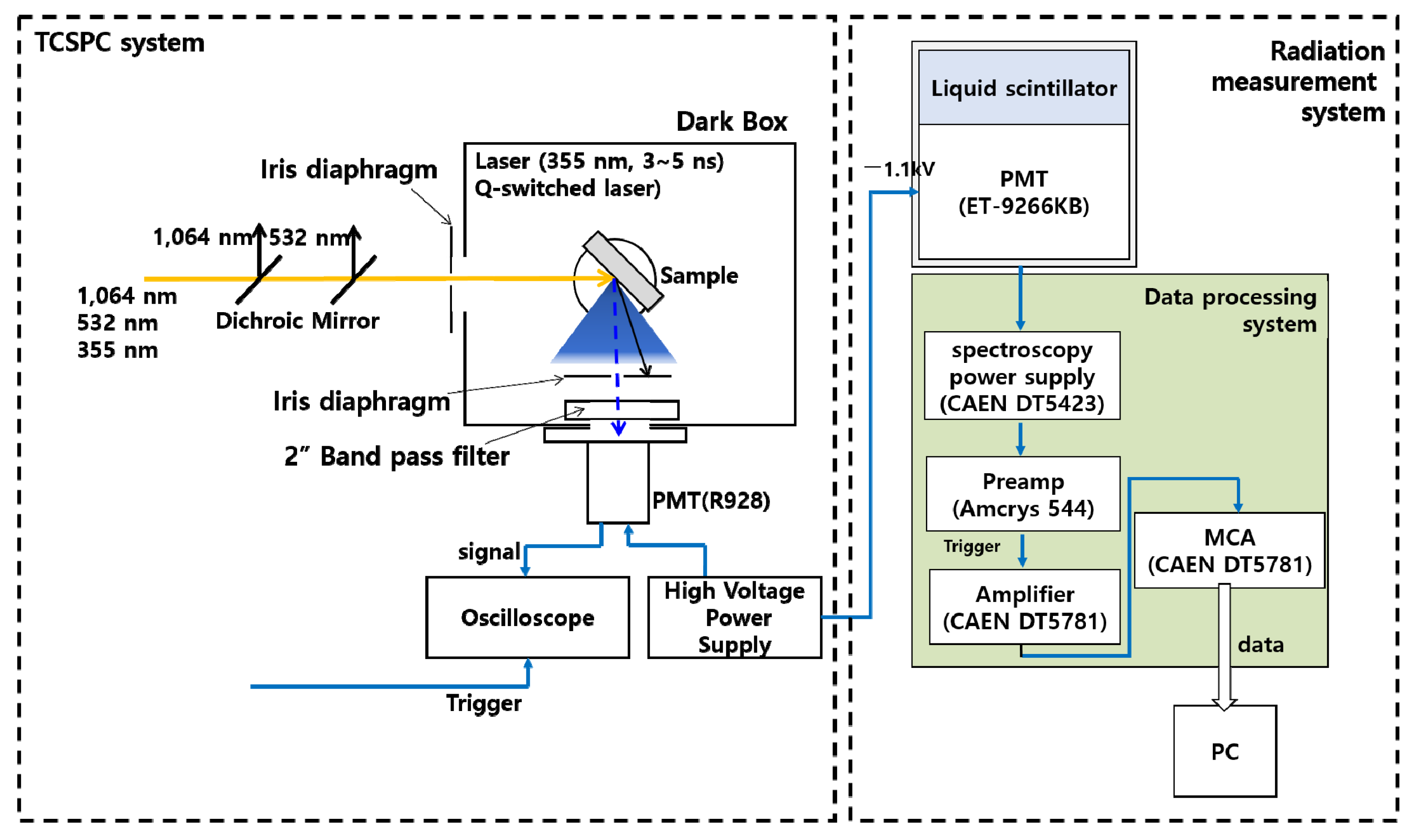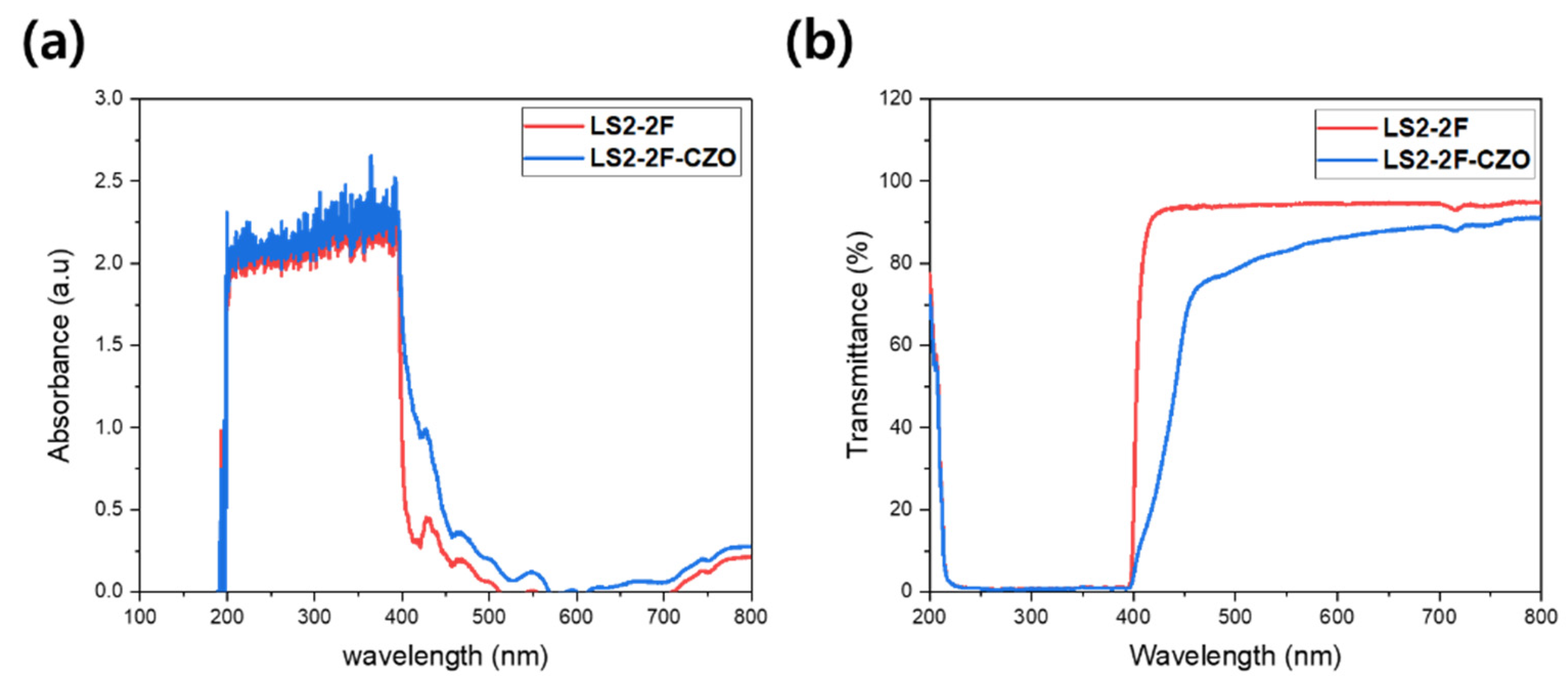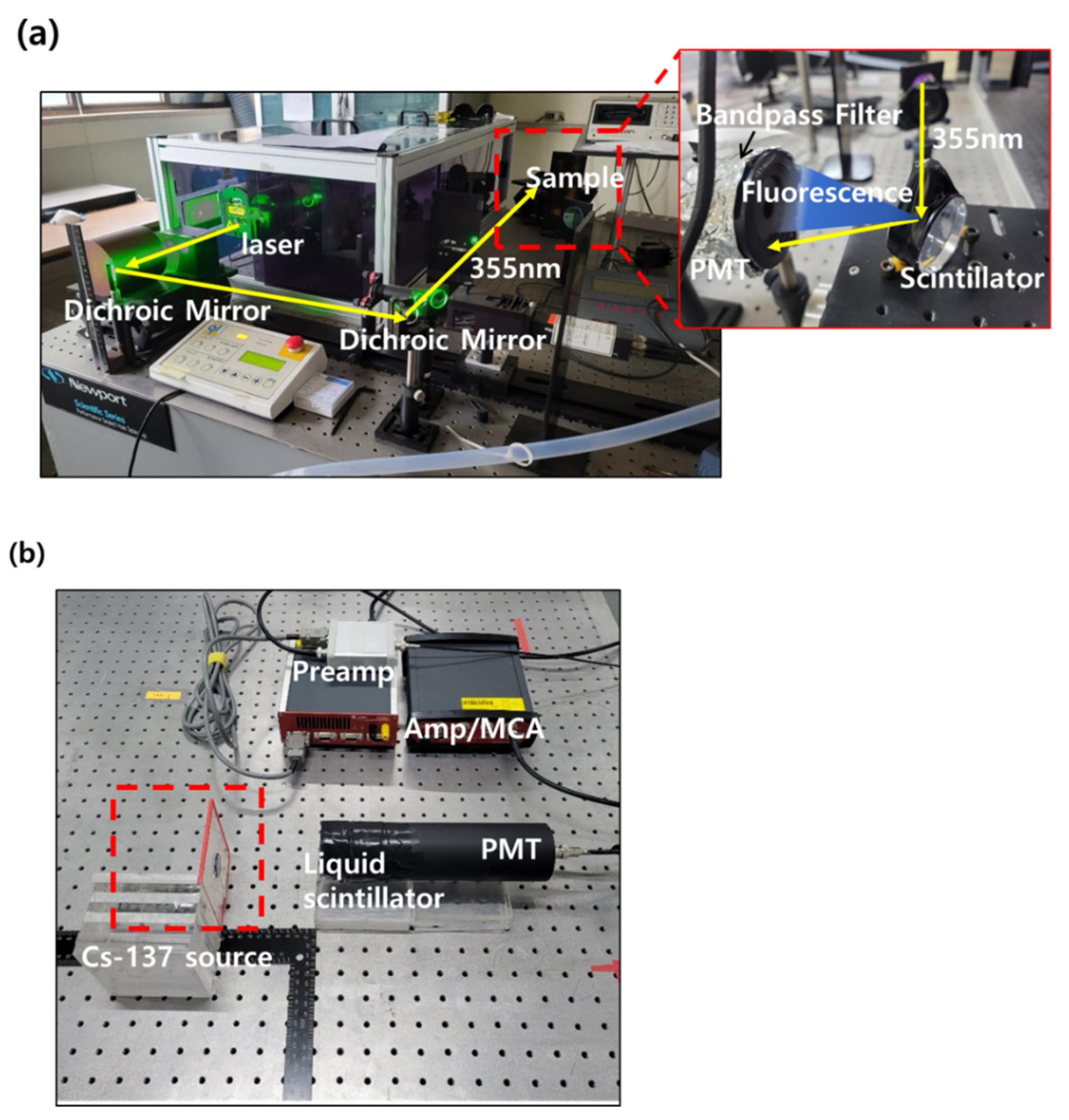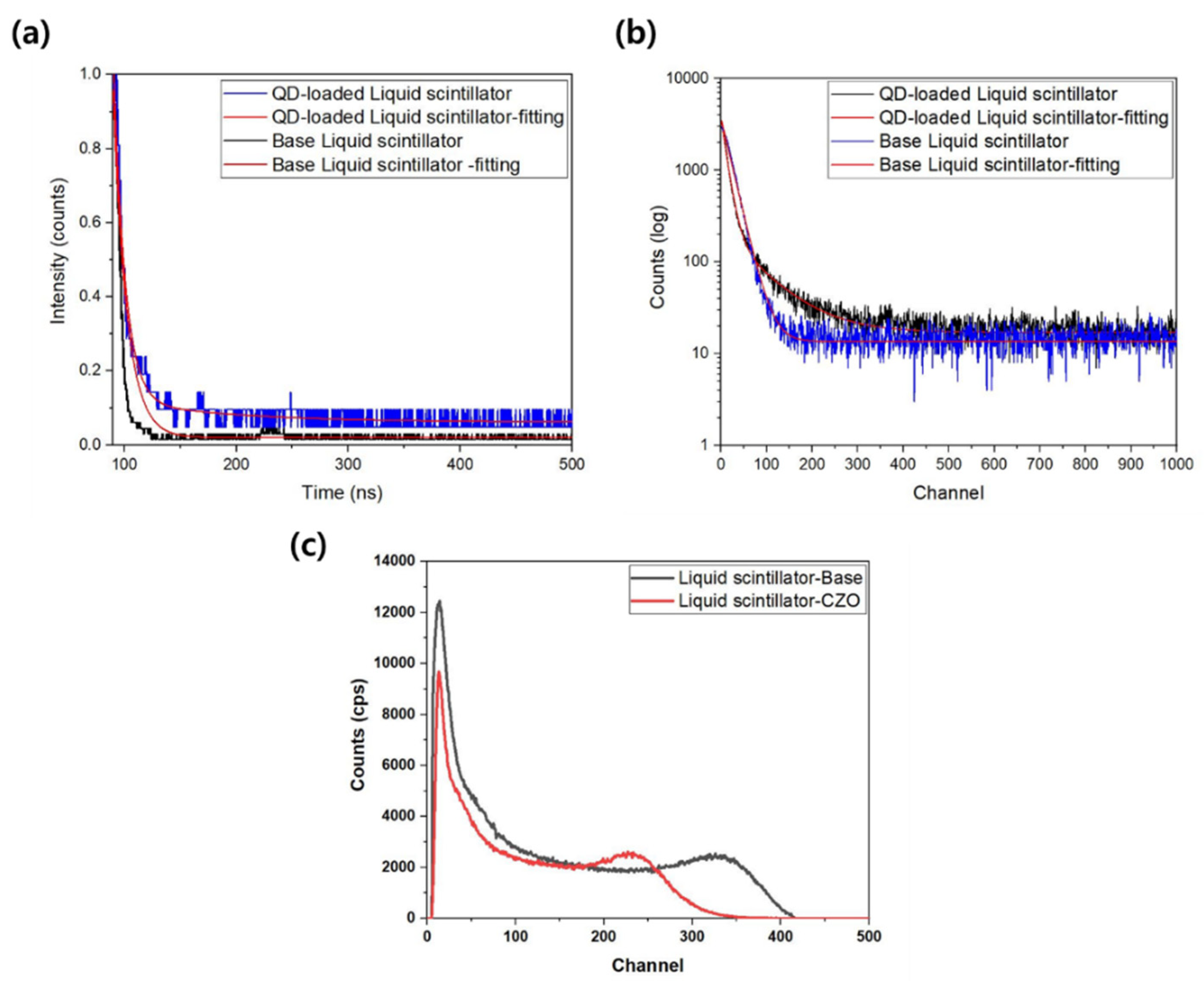Integration of Decay Time Analysis and Radiation Measurement for Quantum-Dot-Based Scintillator’s Characterization
Abstract
:1. Introduction
2. Materials and Methods
2.1. Chemicals and Analysis
2.2. Fabrication of a Liquid Scintillator
2.3. Set-Up of the TCSPC System and Radiation Measurement System
3. Results
3.1. Characteristics of the Liquid Scintillator
3.2. TCSPC Analysis and Radiation Measurement
4. Conclusions
Author Contributions
Funding
Data Availability Statement
Acknowledgments
Conflicts of Interest
References
- Min, S.J.; Kang, H.R.; Seo, B.K.; Cheong, J.H.; Roh, C.H.; Hong, S.B. Wireless backpack system for detection of radioactive cesium on contaminated soil using portable plasitc scintillator with efficient readout device. Electronics 2021, 10, 2833. [Google Scholar] [CrossRef]
- Min, S.J.; Ko, K.H.; Seo, B.K.; Cheong, J.H.; Roh, C.H.; Hong, S.B. Integrated and portable based on functional plastic scintillator for detection of radioactive cesium. Appl. Sci. 2021, 11, 5210. [Google Scholar] [CrossRef]
- Kim, H.J.; Hyun, Y.J.; Kim, Y.J.; Hwang, S.I. A study on effective management scheme for soil and groundwater contamination by radioactive materials due to nuclear accidents. J. Soil Groundw. Environ. 2011, 16, 113–121. [Google Scholar] [CrossRef]
- Lee, K.J. Development of a Vehicle-Mounted Large Area Radioactive Contamination Measurement Equipment. Master’s Thesis, Josun University, Gwangju, Korea, February 2020. [Google Scholar]
- Lee, B.C.; Hong, S.B.; Seo, B.K.; Kim, J.H.; Kim, Y.E. Gamma-ray spectrometry to find the distribution of diffused radioactive sources underground. New Phys. Sae Mulli 2019, 69, 882. [Google Scholar] [CrossRef]
- Ji, Y.Y.; Min, B.I.; Seo, K.S.; Jeong, S.Y.; Kim, K.P.; Park, J.H. Technical status of environmental radiation monitoring using a UAV and its field application to the aerial survey. J. Korea Ind. Inf. Syst. Res. 2020, 25, 31–39. [Google Scholar] [CrossRef]
- Min, S.J.; Seo, B.K.; Roh, C.H.; Hong, S.B.; Cheong, J.H. Phoswich detectors in sensing applications. Sensors 2021, 21, 4047. [Google Scholar] [CrossRef] [PubMed]
- Gweon, D.G. Design and Analysis of Spectral Fluorescence Lifetime Imaging Microscopy Using Tunable Bandpass Filter. Master’s Thesis, Korea Advanced Institute of Science and Technology (KAIST), Daejeon, Korea, February 2012. [Google Scholar]
- Gratton, E.; Breusegem, S.; Sutin, J.; Ruan, Q.; Barry, N. Fluorescence lifetime imaging for the two-photon microscope: Time domain and frequency domain methods. J. Biomed. Opt. 2003, 8, 381–390. [Google Scholar] [CrossRef]
- Jiang, W.; Chalich, Y.; Deen, M.J. Sensors for positron emission tomography application. Sensors 2019, 19, 5019. [Google Scholar] [CrossRef] [PubMed]
- Jiang, W.; Scott, R.; Deen, M.J. Differential quench and reset circuit for single-photon avalanche diodes. J. Lightwave Technol. 2021, 39, 7334–7342. [Google Scholar] [CrossRef]
- Jiang, W.; Chalich, Y.; Scott, R.; Deen, M.J. Time-gated and Multi-Junction SPADs in Standard 65 nm CMOS Technology. IEEE Sens. J. 2021, 21, 12092–12103. [Google Scholar] [CrossRef]
- Alayed, M.; Palubiak, D.P.; Deen, M.J. Characterization of a time-resolved diffuse optical spectroscopy prototype using low-cost, compact single photon avalanche detectors for tissue optics application. Sensors 2018, 18, 3680. [Google Scholar] [CrossRef]
- Alayed, M.; Naser, M.A.; Aden-Ali, I.; Deen, M.J. Time-resolved diffuse optical tomography system using an accelerated inverse problem solver. Opt. Express 2018, 26, 963–979. [Google Scholar] [CrossRef]
- Li, Z.; Deen, M.J.; Kumar, S.; Selvaganapathy, P.R. Raman Spectroscopy for In-Line Water Quality Monitoring-Instrumentation and Potential. Sensors 2014, 14, 17275–17303. [Google Scholar] [CrossRef]
- Li, Z.; Deen, M.J. Towards a Portable Raman Spectrometer Using a Concave Grating and a Time-gated CMOS SPAD. Opt. Express 2014, 22, 18736–18747. [Google Scholar] [CrossRef]
- Pellegrini, S.; Buller, G.S.; Smith, J.M.; Wallace, A.M. Laser-based distance measurement using picosecond resolution time-correlated single-photon counting. Meas. Sci. Technol. 2000, 11, 712–716. [Google Scholar] [CrossRef]
- Li, B.; Bartos, J.; Xie, Y.; Huang, S.W. Time-magnified photon counting with 550-fs resolution. Optica 2021, 8, 1109–1112. [Google Scholar] [CrossRef]
- Becker, W.; Bergmann, A.; Briskup, C. Multispectral Fluorescence Lifetime Imaging by TCSPC. Microsc. Res. Tech. 2007, 70, 403–409. [Google Scholar] [CrossRef]
- Datta, R.; Gillette, A.; Stefely, M.; Skala, M.C. Recent innovations in fluorescence lifetime imaging microscopy for biology and medicine. J. Biomed. Opt. 2021, 26, 070603. [Google Scholar] [CrossRef]
- Farina, S.; Acconcia, G.; Labanca, I.; Ghioni, M.; Rech, I. Toward ultra-fast time-correlated single-photon counting: A compact module to surpass the pile-up limit. Rev. Sci. Instrum. 2021, 92, 063702. [Google Scholar] [CrossRef]
- Becker, W.; Hickl, H.; Zander, C.; Drexhage, K.H.; Sauer, M.; Siebert, S.; Wolfrum, J. Time-resolved detection and identification of single analyte molecules in microcapillaries by time-correlated single-photon counting (TCSPC). Rev. Sci. Instrum. 1999, 70, 1835. [Google Scholar] [CrossRef]
- Samimi, K.; Guzman, E.C.; Trier, S.M.; Pham, D.L.; Qian, T.; Skala, M.C. Time-domain single photon-excited autofluorescence lifetime for label-free detection of T cell activation. Opt. Lett. 2021, 46, 2168–2171. [Google Scholar] [CrossRef]
- Liu, X.; Ma, Y.; Li, S.; Yang, J.; Zhang, Z.; Tian, X. Photon counting correction method to improve the quality of reconstructed images in single photon compressive imaging systems. Opt. Express 2021, 29, 37945–37961. [Google Scholar] [CrossRef]
- Man, M.T.; Lee, H.S. Clarifying photoluminescence decay dynamics of self-assembled quantum dots. Sci. Rep. 2019, 9, 4613. [Google Scholar] [CrossRef]
- Onken, D.R.; Moretti, F.; Caravaca, J.; Yeh, M.; Gann, G.D.O.; Bourret, E.D. Time response of water-based liquid scintillator from X-ray excitation. Mater. Adv. 2020, 1, 71–76. [Google Scholar] [CrossRef]
- Zhao, H.; Yu, H.; Redding, C.; Li, Z.; Chen, T.; Meng, Y.; Hajagos, T.J.; Hayward, J.P.; Pei, Q. Scintillation Liquids loaded with Hafnium Oxide Nanoparticles for spectral resolution of gamma rays. Appl. Nano Mater. 2021, 4, 1220–1227. [Google Scholar] [CrossRef]
- Cresswell, A.; Sanderson, D.; Murpgy, S. Improved NaI(Tl) and CsI(Tl)Detector Arrays for Environmental Airborne Gamma Spectrometry: Technical Progress Report; Technical Report; Scottish Universities Research and Reactor Centre: East Kilbride, UK, 1999. [Google Scholar]
- Gundacker, S.; Turtos, R.M.; Auffray, E.; Lecoq, P. Precise rise and decay time measurements of inorganic scintillators by means of X-ray and 511keV excitation. Nucl. Instrum. Methods Phys. Res. Sect. A 2018, 891, 42–52. [Google Scholar] [CrossRef]
- Park, J.M.; Kim, H.J.; Hwang, Y.S.; Kim, D.H.; Park, H.W. Scintillation properties of quantum dot styrene based plastic scintillators. J. Lumin. 2014, 146, 157–161. [Google Scholar] [CrossRef]
- Sato, A.; Magi, A.; Koshimizu, M.; Fujimoto, Y.; Kishimoto, S.; Asai, K. Photoluminescence and scintillation characteristics of Bi-loaded PVK-based plastic scintillators for the high counting rate measurement of high energy X-rays. RCS Adv. 2021, 11, 15581–15589. [Google Scholar] [CrossRef]
- Ahirwar, S.; Mallick, S.; Bahadur, D. Electrochemical method to prepare graphene quantum dots and graphene oxide quantum dots. ACS Omega 2017, 2, 8343–8353. [Google Scholar] [CrossRef]
- Franizza, E.; Urso, C.; Iacobazzi, R.M.; Depalo, N.; Corricelli, M.; Panniello, A.; Agostiano, A.; Denora, N.; Laquintana, V.; Striccoli, M.; et al. Fabrication of photoactive heterostructures based on quantum dots decorated with Au nanoparticles. Sci. Technol. Adv. Mater. 2016, 17, 98–108. [Google Scholar] [CrossRef] [Green Version]
- Yuan, C.T.; Chou, W.C.; Tang, J.; Lin, C.A.; Chang, W.H.; Shen, J.L.; Chuu, D.S. Single fluorescent gold nanoclusters. Optics Express 2009, 17, 16111–16118. [Google Scholar] [CrossRef]
- Uddin, J.; Ghann, W. Terahertz spectroscopic studies of quantum dots–conjugated gold nanoparticles. Mater. Sci. Eng. 2018, 2, 75–81. [Google Scholar] [CrossRef]
- Rajakrishna, K.; Dhanasekaran, A.; Yuvaraj, N.; Ajoy, K.C.; Venkatraman, B. Effect of high Z materials loading in the performance of polystyrene-based thin-film plastic scintillators. Nucl. Instrum. Methods Phys. Res. Sect. A 2021, 1008, 165454. [Google Scholar] [CrossRef]
- Rajakrishna, K.; Dhanasekaran, A.; Yuvaraj, N.; Ajoy, K.C.; Venkatraman, B.; Jose, M.T. Improvement in plastic scintillator with loading of BaFBr:Eu2+ Radioluminescence phosphor. IEEE Trans. Nucl. Sci. 2021, 68, 1286–1295. [Google Scholar] [CrossRef]
- Villemot, V.; Dufour, N.; Mauree, S.; Sabot, B.; Bertrand, G.H.V.; Hamel, M. From sintering to particle discrimination: New opportunities in Metal-organic frameworks scintillators. Adv. Photonics Res. 2021, 3, 2100259. [Google Scholar] [CrossRef]
- Cherepy, N.J.; Scanner, R.D.; Beck, P.R.; Swanberg, E.L.; Tillotson, T.M.; Payne, S.A.; Hurlbut, C.R. Bismuth- and lithium-loaded plastic scintillators for gamma and neutron detection. Nucl. Instrum. Methods Phys. Res. Sect. A 2015, 778, 126–132. [Google Scholar] [CrossRef]
- Liu, C.; Li, Z.; Hajagos, T.J.; Kishpaugh, D.; Chen, D.Y.; Pei, Q. Transparent Ultra-High-Loading quantum dot/polymer nanocomposite monolith for gamma scintillation. ACS Nano 2017, 11, 6422–6430. [Google Scholar] [CrossRef]
- Egner, B.V.; Febbraro, M.; Bevins, J.E. Characterization of a boron-loaded deuterated liquid scintillator for fast and thermal neutron detection. Nucl. Instrum. Methods Phys. Res. Sect. A 2021, 996, 165153. [Google Scholar] [CrossRef]
- Xu, Q.; Juang, J.; Liu, J.; Wang, J.; Zhou, S.; Wang, X.; Nie, J.; Guo, Y.; Ouyang, X. Lead halide perovskite quantum dots based liquid scintillator for x-ray detection. Nanotechnology 2021, 32, 205201. [Google Scholar] [CrossRef]








| Component | Model No. | Company |
|---|---|---|
| Laser | Brilliant B | Quantel |
| Dichroic Mirror −532 nm | - | KEOC |
| Dichroic Mirror −355 nm | - | KEOC |
| Iris diaphragm | - | THORLABS |
| Band pass filter | FL355–10 | THORLABS |
| PMT (for TCSPC) | R928 | Hamamatsu Photonics |
| High Voltage Power Supply | PS325/2500 V−25 W | Stanford Research Systems |
| Oscilloscope | DS6104 | RIGOL |
| PMT (for radiation measurement) | ET−9266KB | ET-Enterprises Ltd. |
| Preamplifier | Amcrys 544 | Amcrys |
| Amplifier | CAEN DT5781 | CAEN |
| MCA | CAEN DT5781 | CAEN |
| τ1 (ns) | τ2 (ns) | τavg (ns) | χ2 | |
|---|---|---|---|---|
| Base | 2.18 | - | 2.18 | 1.66 |
| CZO-loaded liquid scintillator | 11.47 | 12.43 | 11.95 | 1.17 |
| No. | Materials | Decay Time (ns) | Method | Refs. | |
|---|---|---|---|---|---|
| Decay Time Analysis | Radiation Measurement | ||||
| 1 | BGO (Bi4Ge3O12) | 300 | Decay time is not analyzed | -This is a research case comparing the performance of NaI (Tl) and CsI (Tl), and its intended resolution and efficiency by adjusting HV, timing, and gain, among others. -Photopeak analysis was performed using Cs-137, Co-60, and Ba-133 sources. | [28] |
| 2 | CsI (Tl) | 900 | |||
| 3 | NaI (Tl) | 230 | |||
| 4 | Typical Plastic | 2~2.5 | |||
| 5 | GAGG:Ce | 203 | Using X-ray and 511 keV excitation | No detection properties were performed | [29] |
| 6 | GAGG:Ce:Mg | 124 | |||
| 7 | LuAG:Ce | 940.5 | |||
| 8 | LuAG:Ce:Mg | 358 | |||
| 9 | YAG:Ce | 271 | |||
| 10 | YAG:Ce:Mg | 92.5 | |||
| 11 | LuAG:Pr | 473 | |||
| 12 | Plastic (Styrene + PPO + CdSe/ZnS) | 6.9 | Using Cs-137 (661 keV) gamma ray source | No detection properties were performed | [30] |
| 13 | Plasitc (PVK + bis-MSB + 0 wt% BiPh3) | 6.9 | Using a flashlamp-pumped 266 nm Nd/YAG laser | Observe the pulse height spectra of a scintillation detector equipped with a PVK-based plastic scintillator with different bis-MSB contents at 67.41 keV X-ray | [31] |
| 14 | Plasitc (PVK + bis-MSB + 5 wt% BiPh3) | 5.3 | |||
| 15 | Plasitc (PVK + bis-MSB + 10 wt% BiPh3) | 5.1 | |||
| 16 | Plasitc (PVK + bis-MSB + 15 wt% BiPh3) | 4.2 | |||
| 17 | Graphene quantum dot | 2~6 | Using pulsed laser diode (excited at 375 nm) | No detection properties were performed | [32] |
| 18 | CdSe/ZnS | 14 | Using picosecond laser diode 375 nm (NanoLED 375 L) | No detection properties were performed | [33] |
| 19 | Au nanocrystal | 7 | Using pulsed laser diode (excited at ~460 nm) | No detection properties were performed | [34] |
| 20 | CdSe/Zn QD | 9.33 | Using pulsed nano LED (Delta LED) 340 nm | No detection properties were performed | [35] |
| 21 | CdSe/Zn-Au nanoparticle | 4.68 | |||
| 22 | Plastic (polystyrene + [BaFBr:Eu2+ or BaF2 or Gd2O3 or Gd2OS or CeO2 or Bi2O3]) | - | Decay time is not analyzed | This study evaluated the performance of alpha, beta, neutron, and gamma (Pu-238, C-14, Sr-90, Am-241, Ba-133, Cs-137, Am-Be) measurement by loading materials with high atomic numbers on plastic-based materials | [36] |
| 23 | Plastic (polystyrene + p-xylene + PPO + POPOP + BaFBr:Eu2+) | ~10 ns | F920 flash lamp (Excited at 290 nm) | This study evaluated the detection performance for alpha, beta, neutron, and gamma (Pu-238, C-14, Cl-36, Sr-90, Am-241, Cs-137, Am-Be) by BaFBr:Eu2+ contents | [37] |
| 24 | MOF-205 (Metal-organic frameworks scintillators) | 14.3 | Using pulsed laser diode (excited at 274 nm) and X-ray excitation | This study evaluated the detection properties for Cm-244, Co-60, Cl-36, Sr-90, and Am-241 sources | [38] |
| 25 | Plastic (PVT + PPO + DPA + TPB + Bismuth carboxylates) | - | Decay time is not analyzed | Gamma and neutron detection characteristics and PSD test were performed using Cs-137 and Cf-252 source | [39] |
| 26 | Plastic (PVT + PPO + DPA + TPB + Lithium carboxylates) | ||||
| 27 | Plastic (PVT + FBtF + BMEP + CZS (CdZnS)) | 7 (For 2% FBtF/PVT sample) | Using 10uCi Cs-137 (661 keV) gamma ray source | This is a case study in which detection characteristics were evaluated for Cs-137 gamma nuclide and photopeak was observed | [40] |
| 28 | Toluene + PPO + POPOP + Boron (Liquid scintillator) | - | Decay time is not analyzed | Gamma and neutron detection characteristics and PSD test were performed using Cs-137, Am-Be, and Pu-Be sources. | [41] |
| 29 | Perovskite (MAPbBr3) (liquid scintillator) | 58.8 | Using picosecond pulsed diode 365 nm | This study evaluated steady-state photoluminescence (PL) and X-ray excited PL spectra by excitation with 365 nm laser and X-ray (X-ray tube with Ag target, operating voltage 45 kV, current 0.2 mA), respectively | [42] |
| 30 | Perovskite (CsPbBr3) (liquid scintillator) | 44.2 | |||
| 31 | Toluene + Napthalene + PBD + POPOP + HfO2 (liquid scintillator) | 3.3 | Using Cs-137 (661 keV) gamma ray source | This is a case study in which detection characteristics were evaluated for Cs-137 gamma nuclide and photopeak was observed using a liquid scintillator | [27] |
| 32 | Toluene + PPO + POPOP + CZO (liquid scintillator) | 11.95 | Nd/YAG laser | In this study, Cs-137 gamma detection characteristics were evaluated using a liquid scintillator | This work |
Publisher’s Note: MDPI stays neutral with regard to jurisdictional claims in published maps and institutional affiliations. |
© 2022 by the authors. Licensee MDPI, Basel, Switzerland. This article is an open access article distributed under the terms and conditions of the Creative Commons Attribution (CC BY) license (https://creativecommons.org/licenses/by/4.0/).
Share and Cite
Min, S.; Ko, K.-H.; Seo, B.; Roh, C.; Hong, S. Integration of Decay Time Analysis and Radiation Measurement for Quantum-Dot-Based Scintillator’s Characterization. Processes 2022, 10, 1920. https://doi.org/10.3390/pr10101920
Min S, Ko K-H, Seo B, Roh C, Hong S. Integration of Decay Time Analysis and Radiation Measurement for Quantum-Dot-Based Scintillator’s Characterization. Processes. 2022; 10(10):1920. https://doi.org/10.3390/pr10101920
Chicago/Turabian StyleMin, Sujung, Kwang-Hoon Ko, Bumkyoung Seo, Changhyun Roh, and Sangbum Hong. 2022. "Integration of Decay Time Analysis and Radiation Measurement for Quantum-Dot-Based Scintillator’s Characterization" Processes 10, no. 10: 1920. https://doi.org/10.3390/pr10101920







